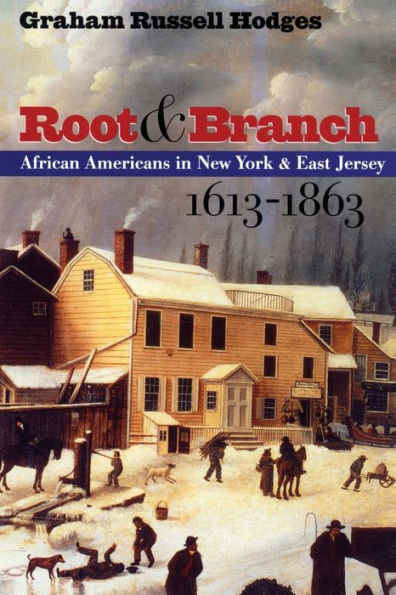
Root and Branch: African Americans in New York and East Jersey, 1613-1863
424
Root and Branch: African Americans in New York and East Jersey, 1613-1863
424Paperback(1)
-
PICK UP IN STORECheck Availability at Nearby Stores
Available within 2 business hours
Related collections and offers
Overview

Product Details
| ISBN-13: | 9780807847787 |
|---|---|
| Publisher: | The University of North Carolina Press |
| Publication date: | 10/04/1999 |
| Series: | The John Hope Franklin Series in African American History and Culture |
| Edition description: | 1 |
| Pages: | 424 |
| Sales rank: | 1,158,996 |
| Product dimensions: | 6.12(w) x 9.25(h) x 0.95(d) |
About the Author
Table of Contents
CONTENTS Acknowledgments Introduction Chapter 1. Free People and Slaves, 1613-1664
Chapter 2. The Closing Vise of Slavery, 1664-1714
Chapter 3. The Thirty-Year Rebellion, 1714-1741
Chapter 4. From Conspiracy to Revolution, 1741-1776
Chapter 5. The Black American Revolution, 1776-1783
Chapter 6. Gradually Free, 1783-1804
Chapter 7. Making a Free People, 1804-1827
Chapter 8. The Black Renaissance amidst White Racism, 1827-1860
Epilogue Appendix Notes Bibliography Index
Illustrations
Manatus map of New Amsterdam, 1639
Portrait of New Amsterdam, 1643
Map of the farms of free blacks, 1640s City of Loango (Luanda), 1670
Slave Trading in New Amsterdam
Castle of El Mina, 1670
Meal Market, 1711
A New Map of New England, ca. 1685
Proclamation of Governor Hunter, 1711
A Law for Regulating Negroes and Slaves in the Night Time, 1731
Bill of sale for a black woman, New York, 1740
Title page of Daniel Horsmanden's Journal of the Proceedings
Plan of the City of New York, 1755
Black Servant
Slave Housing in Old New York
Ye Execution of Goff ye Neger of Mr. Cochins on ye Commons
Map of the Province of New-York, 1776
Peter Williams Sr.
Peter Williams Jr.
Title Page of the "African Free School Notebook," 1822
Playbill for a performance at the African Grove Theatre, 1821
Pierre Toussaint
Black and White Beaux, 1826
Butter and milk seller
Five Points, 1827
Hot corn seller Sylvia Du Bois and her daughter Elizabeth Alexander, 1882
On the waterfront, 1850s
Toko, ca. 1845
Sam the Witch Doctor and Yon the Fiddler Gethsemane Cemetery grave sites, Little Ferry, New Jersey Playground of the Colored Orphan Asylum Middle-class black woman, 1860s
What People are Saying About This
Root & Branch sheds tremendous light upon African-American community formation in the urban North. . . . Hodges has managed to paint a complete and complex picture of the transition from slavery to freedom made by African Americans. Hodges's narrative proves exceptionally strong in the arenas of religion and rebellion.—Journal of the Early Republic
Hodges eloquently refutes the notion that northern slavery was more benign than its southern or Caribbean counterparts. . . . A superb work of scholarship. Hodges has mined a truly impressive range of materials to create a compelling account of the contours of black life in a region that historians of slavery have generally chosen to ignore.—Journal of American History
A thoroughly researched and compelling picture of African Americans in New York and East Jersey forging a distinctive, syncretic culture that served as the engine of their struggle for freedom.—American Historical Review
In this compelling and provocative book, Graham Hodges asks us to look at the early history of African Americans in the New York region with fresh eyes. . . . Hodges's work clearly deserves the attention of all who study African Americans in the mid-Atlantic area. This compact overview of the struggles of the founding generations of New York's large and influential black community offers the mature reflections of a scholar who has spent many years recovering the stories of a people who indelibly shaped the region's history.—Pennsylvania Magazine of History and Biography
Hodges has taken on the commendable and consuming task of writing the history of black New York from its colonial beginnings in 1613 through the tumultuous early years of the Civil War. . . . Hodges has contributed tremendously not only to the historiography of African-American life, but also to the narratives of colonial, early American, and antebellum history.—Journal of the Early Republic
Hodges's praiseworthy effort displays the rich source material and potential in the story of black New York generations before Harlem's rise. His efforts to connect his findings to recent scholarship on slavery and black identity and cultural development further suggest the capacity black New York's story holds to clarify both traditional and alternative paradigms for the contested meaning of slavery, African-American community formation, and race relations.—William and Mary Quarterly
Provides the first comprehensive account of New York City blacks. . . . [This] sweeping history is filled with information and thoughtful analysis.—Choice
Hodges not only redirects attention to New York and East Jersey, a region of intensive slavery and significant African-American presence, but also extends the chronological scope of inquiry by starting in the early seventeenth century. . . . His discussion of African-Americans in the era of the American Revolution is particularly valuable, for it reveals how the potential for African-American freedom at the end of slavery was circumscribed. . . . A useful book that draws attention to an important African-American community.—Times Literary Supplement
This well-crafted and thoughtful work is a splendid addition to the literature on African societies in North America from first arrivals through the triumph of the abolition movement.—Wilson J. Moses, Pennsylvania State University
